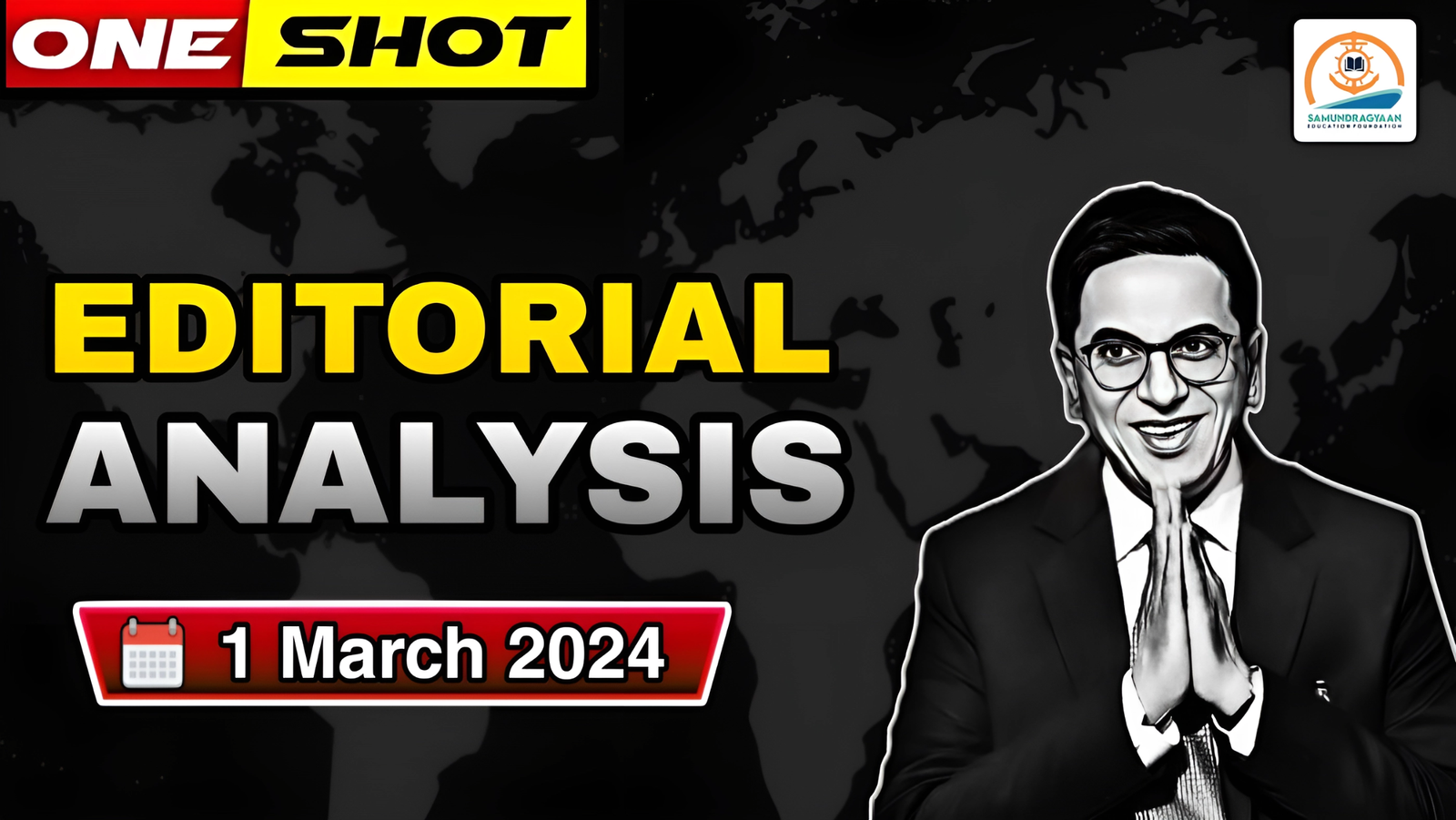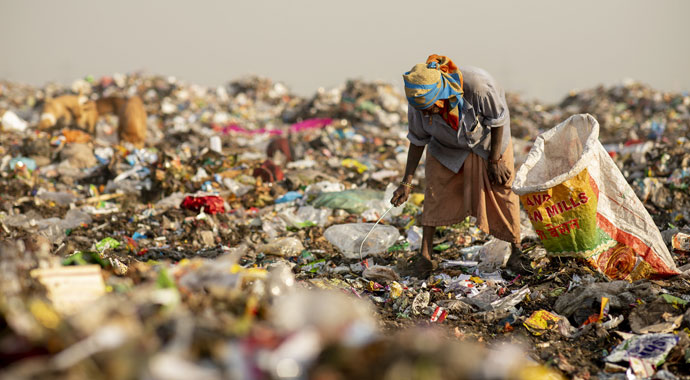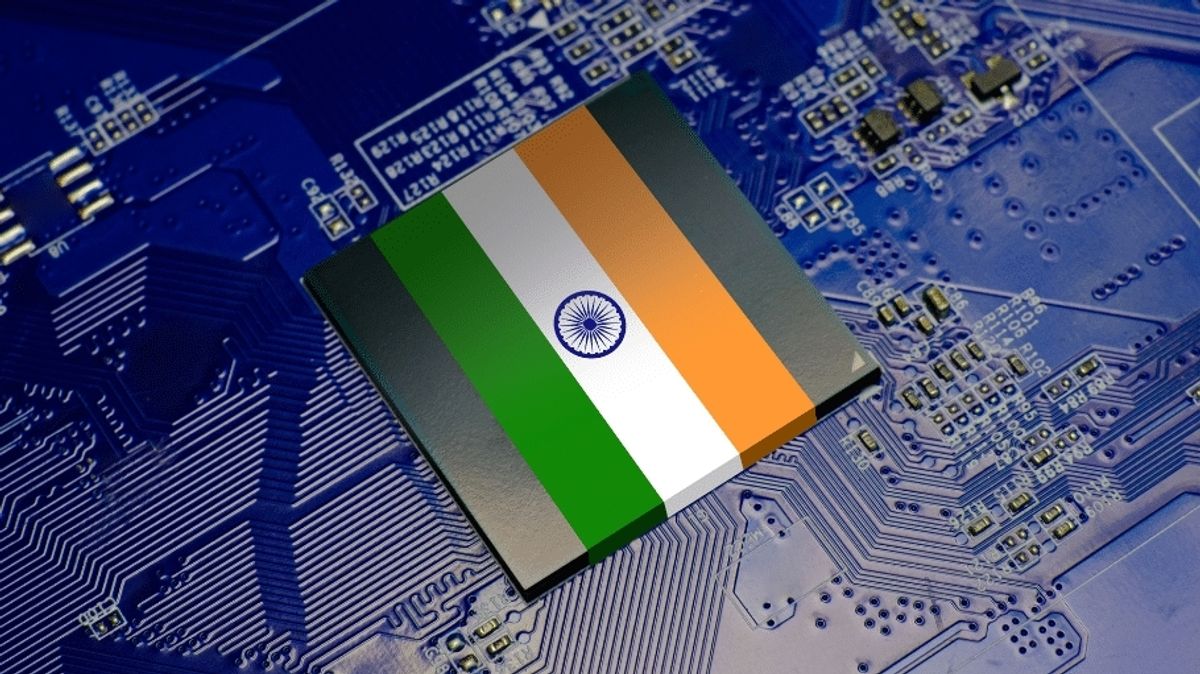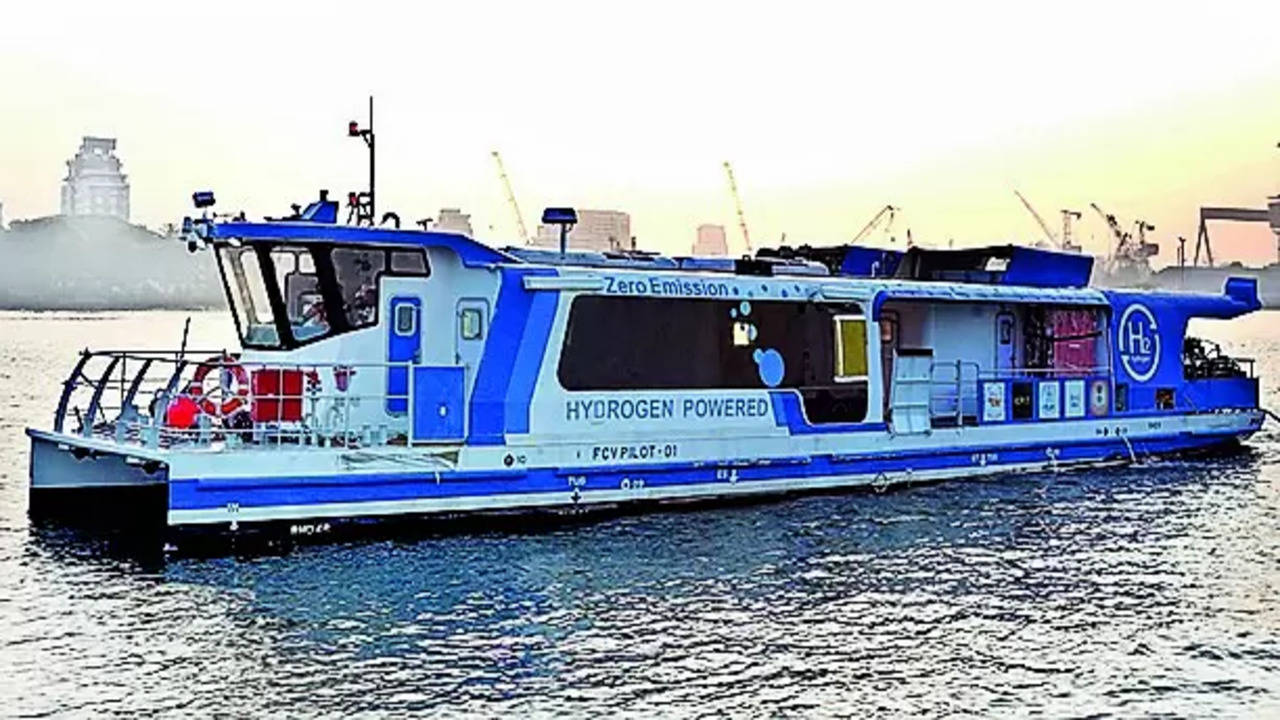Why in news?
- Prime Minister Narendra Modi on Wednesday virtually launched India’s first indigenously developed hydrogen fuel cell ferry.
- The vessel, manufactured by Cochin Shipyard Limited (CSL), will be deployed for service at Varanasi in Uttar Pradesh.
- The hydrogen fuel cell system was developed by KPIT Technologies, Pune, in collaboration with the Council of Scientific and Industrial Research Labs, under the Union Ministry of Science and Technology.
What’s in today’s article?
- Harit Nauka initiative
- Hydrogen fuel cells
- News Summary
Harit Nauka (green boat) initiative
- This is the initiative of the Ministry of Ports, Shipping and Waterways. It envisages a green transition of inland vessels.
- In January 2024, the shipping ministry unveiled the Harit Nauka guidelines for inland vessels.
- As per the guidelines, all states have to make efforts to use green fuels for 50 per cent of inland waterways-based passenger fleets in the next one decade, and 100 per cent by 2045.
- This is to reduce greenhouse gas emissions as per the Maritime Amrit Kaal Vision 2047.
- In line with this, the ferry can be replicated in other parts of the country for urban mobility. It is also a boost to the National Green Hydrogen Mission.
Hydrogen fuel cells
- About
- A hydrogen fuel cell uses the chemical energy of hydrogen to produce electricity.
- It is a clean form of energy with electricity, heat and water being the only products and by-products.
- Working
- Fuel cells work like batteries, but they do not run down or need recharging. They produce electricity and heat as long as fuel is supplied.
- A fuel cell consists of two electrodes—a negative electrode (or anode) and a positive electrode (or cathode)—sandwiched around an electrolyte.
- A fuel, hydrogen in this case, is fed to the anode, and air is fed to the cathode.
- A catalyst at the anode separates hydrogen molecules into protons and electrons, which take different paths to the cathode.
- The electrons go through an external circuit, creating a flow of electricity.
- The protons migrate through the electrolyte to the cathode, where they unite with oxygen and the electrons to produce water and heat.
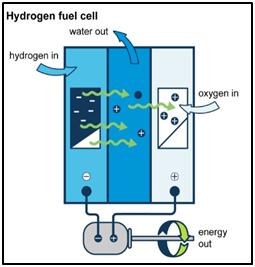
- Limitations in India
- High Cost:
- Fuel cell systems are still relatively expensive compared to traditional energy sources.
- Lack of Infrastructure:
- India currently lacks the infrastructure needed to support the widespread adoption of fuel cell technology, including hydrogen production and distribution networks.
- Technical Challenges:
- Fuel cell technology is still in its early stages of development, and there are ongoing technical challenges.
- Policy Limitations:
- The Indian government has yet to put in place a comprehensive policy framework to support the development and adoption of fuel cell technology.
- This has limited the growth of the industry and hindered investment in research and development.
- Steps taken by India
- The National Green Hydrogen Policy has been developed to outline a vision for the growth of the hydrogen and fuel cell industry in India.
- The aim of the National Green Hydrogen Policy is to make India the Global Hub for production, usage and export of Green Hydrogen and its derivatives.
News Summary: PM Modi launches hydrogen-powered ferry
- PM Modi virtually launched India’s first indigenously developed hydrogen fuel cell ferry.
- The Ministry of Ports, Shipping and Waterways met 75 per cent of the project cost.
Features of the ferry
- Length and carrying capacity
- The Hydrogen fuel cell vessel is a 24-meter-long catamaran, which can carry 50 people in its air-conditioned passenger area.
- Does not use conventional batteries
- Hydrogen fuel cell vessels do not use conventional batteries as the primary storage house of electrical energy.
- The vessels run on hydrogen fuel, which is stored in cylinders.
- This boat has five hydrogen cylinders that can carry 40kg of hydrogen and support eight hours of operations.
- The vessel is also fitted with a 3-kW solar panel.
- Type of cells used in the vessel
- This vessel uses a 50-kW PEM (proton-exchange membrane) fuel cell, with Lithium-Ion Phosphate batteries.
- The advantage is that the cells can quickly change their output depending upon the power demand.
- PEM fuel cells are popular in automotive applications because they operate at a lower temperature, and are lighter and more compact.
- Environment friendly
- The hydrogen fuel cell-powered vessel has zero emission, zero noise and is energy-efficient, which makes it more environment-friendly.
- Since there are no moving parts, the ferry requires less maintenance than combustion vessels.
- Other benefits
- While hydrogen fuel cell technology has been under development for maritime applications, only a few countries globally have done demonstration projects.
- This ferry, thus, has given India an early mover advantage to tap the potential of hydrogen as an emerging green fuel in the marine sector.
GDP Growth Accelerates to 8.4% in Q3
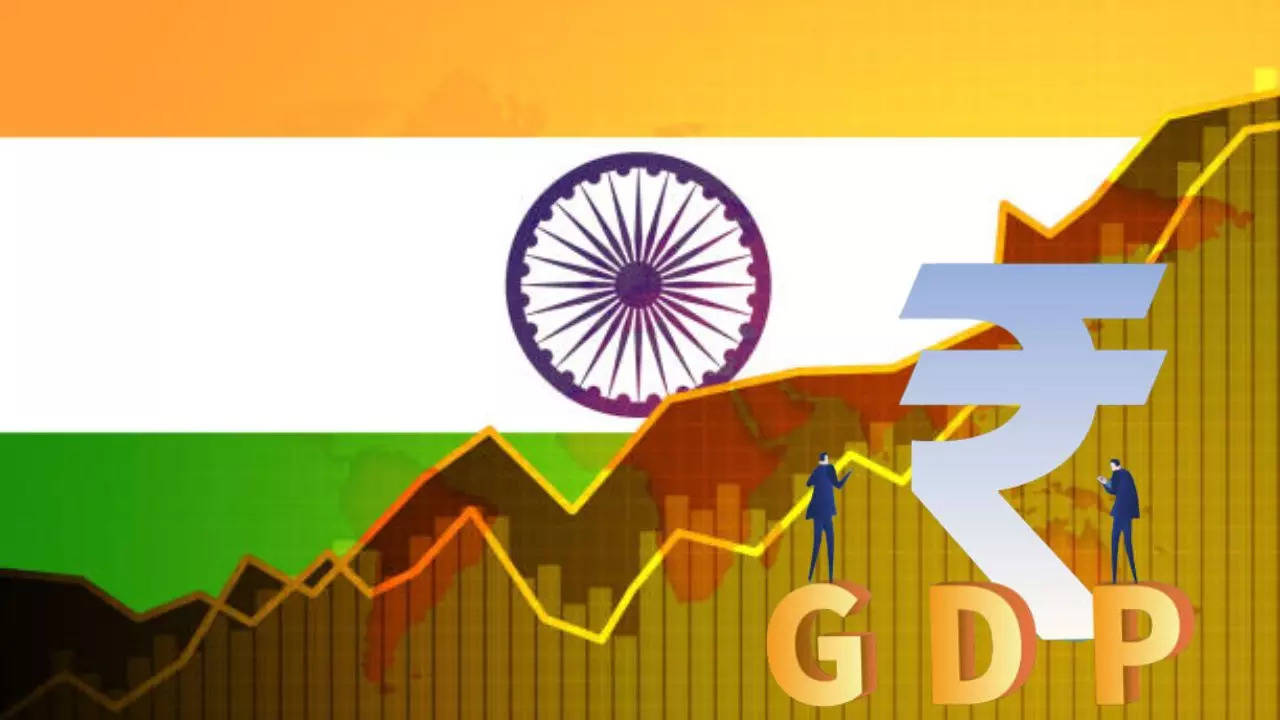
What’s in Today’s Article?
- Background (Context, NSO)
- Key Highlights of the Latest Data (Overall Data, Sector-wise, etc.)
- Key Words for Prelims (GDP, GVA, etc.)
Background:
- India’s Gross Domestic Product (GDP) growth surged to a six-quarter high of 8.4% in October-December period of 2023.
- This has pushed up the growth rate for 2023-24 to 7.6% as against the earlier estimate of 7.3%, data for third quarter GDP and second advance estimates for 2023-24 released by the National Statistical Office showed.
About National Statistical Office (NSO):
- In May 2019, the Central Government merged the National Sample Survey Office (NSSO) and the Central Statistics Office (CSO) under the Ministry of Statistics and Programme Implementation (MoSPI).
- The merger created an overarching body i.e., National Statistical Office.
- Hence, the statistical wing of the MoSPI is now called the NSO.
- NSO acts as the nodal agency for planned development of the statistical system in the country.
- It lays down and maintains norms and standards in the field of statistics, involving concepts and definitions, methodology of data collection, processing of data and dissemination of results.
Key Highlights of the Data Released by the NSO:
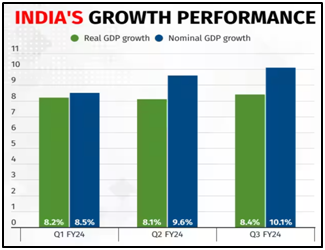
- The estimate for growth in the second quarter has now been revised up to 8.1 percent, while that for the first quarter has been revised higher to 8.2 percent from 7.8 percent.
- At 8.4 percent, the latest quarterly GDP growth rate is the highest in six quarters.
- Last time India’s economy grew at a faster rate was in the first quarter of 2022-23, when it grew by 13.1 percent, now revised down to 12.8 percent.
- The Reserve Bank of India’s projection for growth in Q3 was pegged at 6.5%.
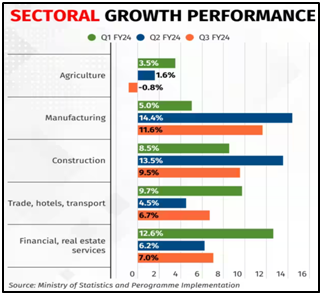
- In the third quarter of the current financial year, among sectors, manufacturing posted the highest growth rate in double digits at 11.6%, while the construction sector grew 9.5%.
- Agriculture recorded a contraction of 0.8% in October-December.
- Private final consumption expenditure, an indicator of consumption demand, rose by 3.5% year-on-year in October-December.
- On the other hand, government final consumption expenditure decreased by 3.2%.
- Gross fixed capital formation, an indicator of investment, grew by 10.6% during the third quarter.
Key Words:
- What is GDP?
- The total monetary or market value of all finished goods and services produced within a country’s borders within a specific period of time is called its gross domestic product (GDP).
- It is a comprehensive measure of the country’s economic health, expressed in terms of the overall domestic production and functions.
- The GDP of a country includes all private and public consumption, government outlays, investments, additions to private inventories, paid-in construction costs, and foreign balance of trade.
- What is GVA?
- In situations where the GDP fails to measure the real economic scenario, the Gross Value Added (GVA) is a better gauge.
- The GVA measures the total value of goods and services produced in an economy, and the amount of value added to a product.
- It is defined as the output produced after the deduction of the intermediate value of consumption. The GVA, in India, is measured at ‘basic prices’.
- How are GDP and GVA Related?
- GDP and GVA are related as follows:
- GDP = GVA + Taxes levied by governments on products – Subsidies provided by government on products
- Typically, the absolute level of GDP is more than the absolute level of GVA because taxes received are more than subsidies spent by the government.
On cross-voting in Rajya Sabha elections
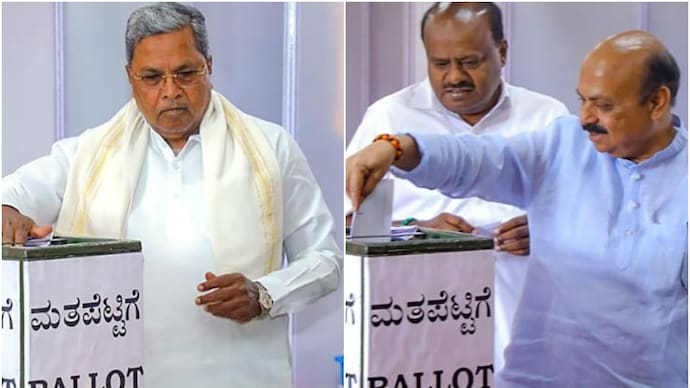
Why in news?
- The Rajya Sabha elections in the States of Uttar Pradesh, Himachal Pradesh and Karnataka witnessed cross-voting by MLAs belonging to different parties.
- This has once again raised concerns about the sanctity of the election process.
What’s in today’s article?
- Rajya Sabha elections
- Tenth Schedule and Rajya Sabha election
- Supreme Court and 10th Schedule
Rajya Sabha elections
- Constitutional provision
- As per Article 80 of the Constitution, representatives of each State to the Rajya Sabha are elected indirectly by the elected members of their Legislative Assembly.
- The polls for Rajya Sabha will be required only if the number of candidates exceed the number of vacancies.
- In fact, till 1998, the outcome of Rajya Sabha elections were usually a foregone conclusion.
- The candidates nominated by various parties, according to their strength in the Assembly, used to be elected unopposed.
- Legal Provision
- The June 1998 Rajya Sabha elections in Maharashtra witnessed cross-voting.
- Hence, in order to rein in the MLAs from such cross-voting, an amendment to the Representation of the People Act, 1951 was carried out in 2003.
- Section 59 of the Act was amended to provide that the voting in elections to Rajya Sabha shall be through an open ballot.
- The MLAs of political parties are required to show their ballot paper to the authorised agent of their Party.
- Not showing the ballot paper to the authorised agent or showing it to anyone else will disqualify the vote.
- Independent MLAs are barred from showing their ballots to anyone.
Tenth Schedule and Rajya Sabha elections
- The 52ndconstitutional amendment introduced the anti-defection law through the Tenth Schedule in 1985.
- This Schedule provides that a member of a House of Parliament or State legislature who voluntarily gives up the membership of their political party or votes against the instructions of their party in a House are liable for disqualification from such House.
- This instruction with respect to voting is issued by the whip of a party.
- However, the elections to Rajya Sabha are not treated as a proceeding within the Legislative Assembly.
- The Election Commission, drawing reference to Supreme Court judgments, had issued a clarification in July 2017.
- It specified that the provisions of the 10thSchedule, with respect to voting against the instruction of the party, will not be applicable for a Rajya Sabha election.
- Furthermore, political parties cannot issue any whip to its members for such elections.
Supreme Court and 10th Schedule
- Kuldip Nayar versus Union of India (2006)
- The Supreme Court in Kuldip Nayar versus Union of India (2006), upheld the system of open ballot for Rajya Sabha elections.
- It reasoned that if secrecy becomes a source for corruption, then transparency has the capacity to remove it.
- The same court held that an elected MLA of a political party would not face disqualification under the Tenth Schedule for voting against their party candidate.
- He/she may at the most attract disciplinary action from their political party.
- Ravi S. Naik and Sanjay Bandekar versus Union of India (1994)
- In this judgement, the apex court held that that voluntarily giving up membership under the Tenth Schedule is not synonymous with only formally resigning from the party to which the member belongs.
- The conduct of a member both inside and outside the house can be looked into to infer if it qualifies as voluntarily giving up membership.
Way forward
- In India, we follow a two-fold principle. When it comes to voting in direct elections where the entire population is involved, we insist on a secret ballot.
- But in legislative chambers, where Bills are to be voted on, we do not insist on secrecy. The voting is open.
- The Rajya Sabha election fell halfway between the two kinds of votes. It elected MPs but the electoral college was not based on universal franchise: only MLAs could vote.
- It was decided that voting for Rajya Sabha candidates had more in common with voting on Bills than with general elections. So, the secret ballot was abolished and voting became public.
- Instances of cross-voting have undermined the higher principle of free and fair elections and their purity.
- Therefore, the court must reconsider its stance on whether cross-voting in such elections can be a valid ground for disqualification under the Tenth Schedule.
- Only then will the intent behind implementing the open ballot system be fully realized.

